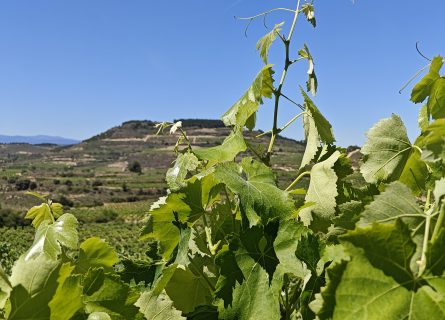
Sipping Sustainably: Exploring Organic Winemaking in Spain
August 5, 2024
Spain's wine industry excels in organic wine production, preserving terroir and ecosystems. Learn about organic winemaking, certifications, and top Spanish wineries.
By: Nicole Indovino / Last updated: January 13, 2025
Did you know that Spain has more land covered in vineyards than any other country? Spanish wines have unparalleled diversity, with more than 60 official wine regions. From the luscious green hills of Galicia to the hot sandy soils of Jerez and everywhere in between, Spanish wines offer robust reds, refreshing whites, sparkling wines (Cava), rosé, and sherry. Indeed, there is a Spanish wine for every palate and every occasion.
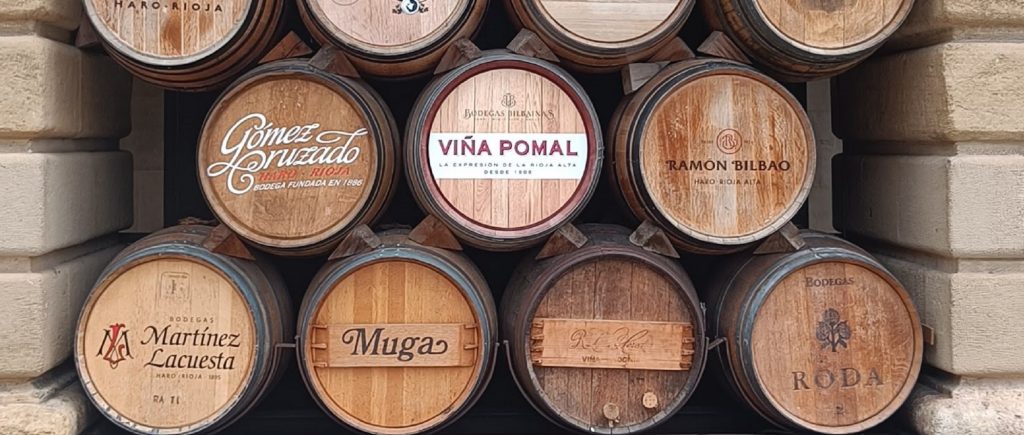
This guide will introduce you to Spain’s fascinating history and culture and direct you through the diverse wine regions, allowing you to explore Spain’s wines confidently.
Spanish winemaking dates back 3,000 years to the Phoenicians, who set up a trading post in Cadiz and made wine in clay amphoras. Centuries later, the Romans significantly increased wine production while ruling over Spain, planting vineyards throughout the peninsula to trade and export wine.
When phylloxera devastated Bordeaux, it compelled many merchants and vintners to migrate to northern Spain in search of new vine stocks. Haro, in the heart of La Rioja, became a wine production center with its rail connections to France and other Spanish regions. Notably, this includes the historic Barrio de la Estación, home to some of the oldest cellars in the area.
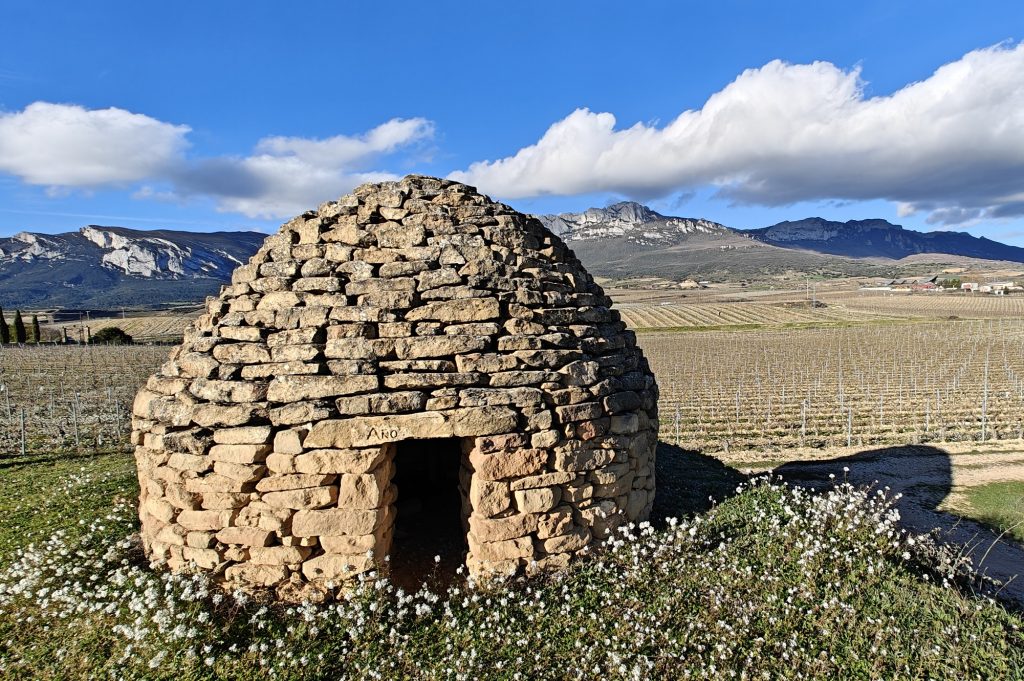
Eventually, phylloxera arrived in Spain. The pest attacked the roots of grapevines, requiring the ripping out and replanting of almost all vineyards. This led to a significant shift in the types of grapes grown and the styles of wine produced.
In the 20th century, the Spanish Civil War led to the destruction and abandonment of many vineyards, further disrupting the wine industry. Following the war under the rule of dictator Franco, many large cooperatives were put in place to mass-produce wine, hurting the reputation of Spanish wine regarding quality.
However, after Franco’s death in the 1970s, the country began to invest and expand, innovating and improving quality, and entering the 21st century as a producer of excellent, quality wines.
Spain’s incredibly diverse geography and climate allow the country to produce a vast range of wines, varying in grape varieties and styles. The northwest of Spain, known for its lush, green, cool climate, is ideal for growing white grapes and producing crisp, acidic, refreshing white wines.
In contrast, southwest Spain’s ‘Sherry Triangle,’ a region encompassing the towns of Jerez de la Frontera, El Puerto de Santa María, and Sanlúcar de Barrameda, has hot, arid temperatures and chalky soils. This creates a unique microclimate for sherry wine production.
The coastal areas of Catalonia and Valencia produce incredible red, white, and sparkling wines aided by cool Mediterranean breezes. Many other astonishing wine regions have unique soils, climates, and proximity to different mountain ranges.
Climate change poses significant challenges for Spain’s wine industry and is already affecting current vintages. With changing precipitation patterns, many wine regions in Spain are experiencing drought stress, especially in Catalonia. This has caused a decline in grape yields and uneven ripening in recent years.
Rising temperatures in hotter regions force winemakers to harvest grapes earlier or with less acidity. Fortunately, winemakers in Spain have an industrial spirit and are adapting quickly. They’re experimenting with adjusting vineyard and winemaking practices, planting indigenous heat-tolerant varieties, and more.
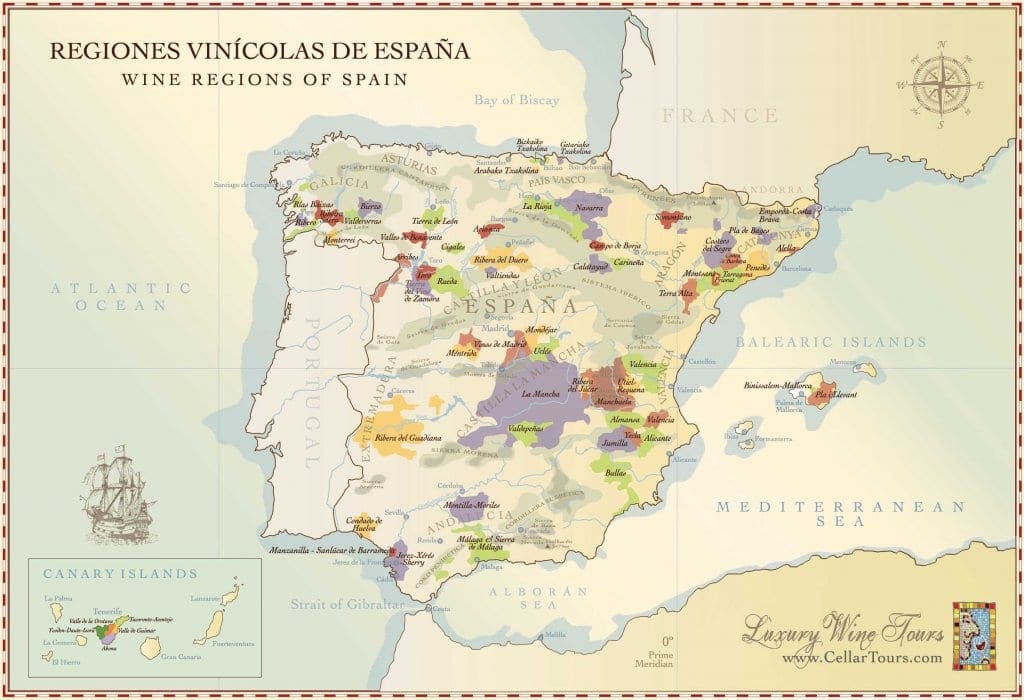
Spain hosts a wide array of grape varietals, many native to their regions, which is a huge point of pride for Spanish vintners. Tempranillo, arguably Spain’s most famous grape, grows in several red wine regions, notably Rioja and Ribera del Duero.
Additionally, Garnacha, another widely planted Spanish red grape, boasts flavors of bright red fruits, like cherries and strawberries, with more savory notes of spices and herbs. Meanwhile, Albariño is a popular white variety from Galicia in northwest Spain.
While these are some of the most popular, Spain has over 400 indigenous grape varieties planted, giving you a world to explore. For instance, you might try a Bobal from Valencia, Monastrell from Jumilla, or Mencía from Bierzo.
Check out our guide on Spanish varietals for more information.
Wine is not just a beverage in Spain; it’s a part of the culture. For centuries, wine has symbolized the blood of Christ in Catholic Mass, reflecting its sacred importance. Moreover, many festivities and celebrations center around wine, such as the Haro Wine Festival, which features a giant wine battle in the streets where everyone sprays each other.
Every day, social gatherings and meals almost always include wine. This fosters connections between families and friends as they spend time together at the table. This deep-rooted cultural significance of wine in Spain is something that every wine enthusiast should experience.
Decoding Spanish wine labels is crucial to understanding what wines you like and how to find a quality bottle. Typical labels feature the region instead of the grapes used and have terms like “Crianza,” “Reserva,” and “Gran Reserva.” Moreover, these terms help indicate not only the aging of the wine but also give us clues about the wine’s profile and quality.
Check out our guide on Spanish wine labels to learn more.
Over the past few decades, the Spanish wine industry has become a leader in organic and sustainable wine production as a means to preserve its incredible winemaking legacy. Currently, 27% of all Spanish wine is organic, with regions like DO Penedés setting the ambitious goal for all vineyards to be certified organic by 2025.
While organic farming can have its challenges, many growers in Spain see it as a way to achieve long-term viability and attract consumers who are more and more conscientious of their health and the environment’s health. To learn more about organic wines in Spain and how to identify a certified organic wine
Discover more with our guide on organic and sustainable Spanish wines.
The wide variety of wine regions, winemaking styles, and grape varieties offer a diverse selection of Spanish wines to pair with food: robust reds from regions like Rioja and Ribera del Duero, which pair beautifully with grilled meats and hearty stews, to crisp Albariños from Rías Baixas, perfect for seafood and light salads. Tempranillo’s rich, earthy notes complement aged cheeses and charcuterie, while the effervescence of Cava is an ideal match for tapas and fried dishes like croquetas.
Check out our guide to learn more about pairing Spanish wine and our recommendations.

Today, Spain’s greatest reds arguably come from Rioja, Ribera del Duero, and Priorat. Balance unites these eclectic regions: producers increasingly prioritize acidity and freshness over brute strength and high alcohol. At the same time, winegrowers are toning down the paradigm of lavishly aging wines in new French barriques.
Modern Spanish winegrowers aim to have their cake and eat it too—they produce the best red wines, making them both gloriously concentrated and refined, with plenty of fresh acidity and poise. This is the face of contemporary Spanish red wine.
Rioja is the country’s most famous wine region, celebrated for its rich winemaking history and exceptional quality. Situated below the Cantabrian mountains in northern Spain, Rioja benefits from the protection of the nearby mountains, the altitude of its vineyards, and its proximity to the Ebro River.
These conditions protect the vineyards from harsh winds and extreme temperatures, making it a perfect site to grow grapes. Rioja wines are known for their balance and elegance, offering great structure and flavors that range from bright fruit in younger wines to savory, earthy notes in aged wines.
La Rioja Wine Region Guide: Read more
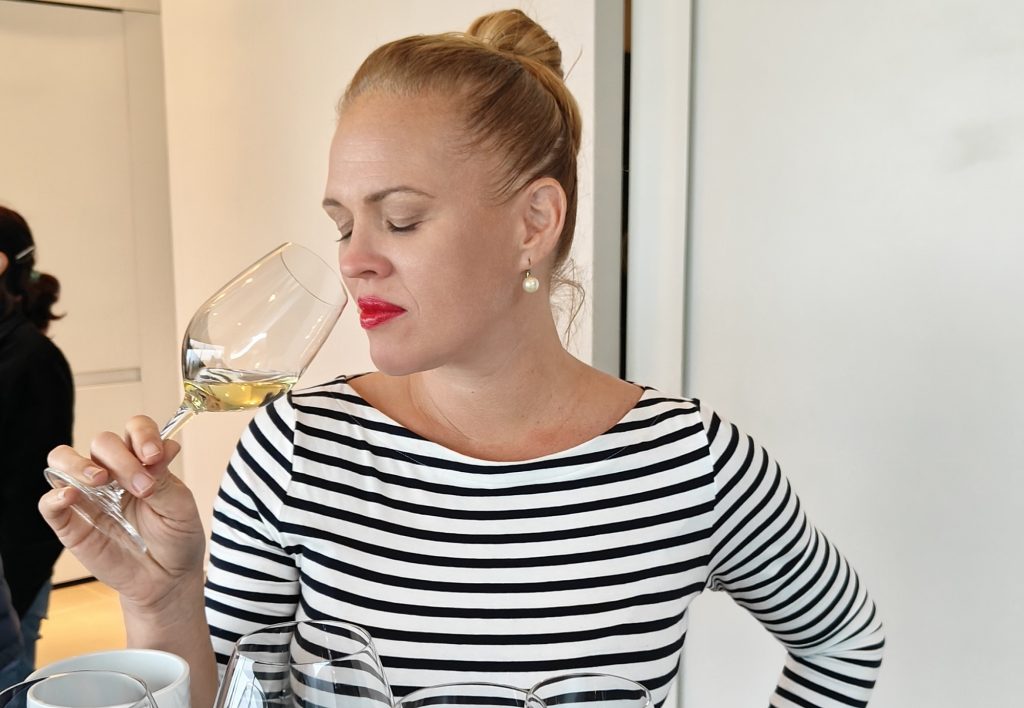
If you’re planning a visit to La Rioja and want to visit its wineries, our guide to Wine Tastings and Visiting Rioja offers valuable insight into where to taste, eat, and stay, as well as must-sees.
Types of Wine: Rioja primarily produces red wines, known for their long aging in the winery (Crianza, Reserva, Gran Reserva). They also produce very limited quantities of white wine and rosé, which make up about 10% of production.
For a deeper understanding of this region and its wine classifications, check out our Rioja Wine Types and Classifications blog post.
Grapes Varieties:
A few hours east of la Rioja, along the Duero River in the heart of Spain, Ribera del Duero is a prestigious wine region known for producing some of the country’s most robust and elegant red wines. The region’s vineyards exist in a harsh environment; strong winds whip through the valley, summers are sweltering, and winters are bitingly cold.
These extremes contribute to the wines’ complexity and intensity, as the grapes have thick skins to combat the conditions. Consequently, the thick skins impart a very powerful tannin structure, deep, rich colors, dark notes of blackberries and plums, and hints of spice when aged.
Ribera Del Duero Wine Region Guide: Read more
Planning a Ribera del Duero wine-tasting tour? Our guide to wine tastings and visits offers recommendations for wineries, restaurants, accommodations, and must-see attractions.
Types of Wine: Ribera del Duero focuses mainly on red wine production, specifically Tempranillo. Unlike Rioja, very few other varieties are planted in the region, and their red wines are often 100% Tempranillo without blending other minor varieties.
Grapes Varieties:
A tiny, isolated region in Catalonia’s remote, rugged hills, Priorat is one of Spain’s most revered wine regions, celebrated for its powerful and complex wines. The vineyards sit on very steep, terraced slopes with slate-rich soils known as “llicorella,” which impart a distinctive minerality to the wines.
The region’s hot, dry Mediterranean climate, with significant temperature variations between day and night, allows the development of concentrated flavors in the Garnacha and Cariñena, the two most planted varieties in the region. The result is intense, inky, age-worthy wines displaying deep, rich flavors of black fruits, licorice, and spices, complemented by a mineral backbone and robust tannins.
Curious about Priorat wines? Discover everything you need to know in our guide to Priorat Wine Types and Classifications!
Priorat Wine Region Guide: Read more
Types of Wine: Red wines
Grapes Varieties:
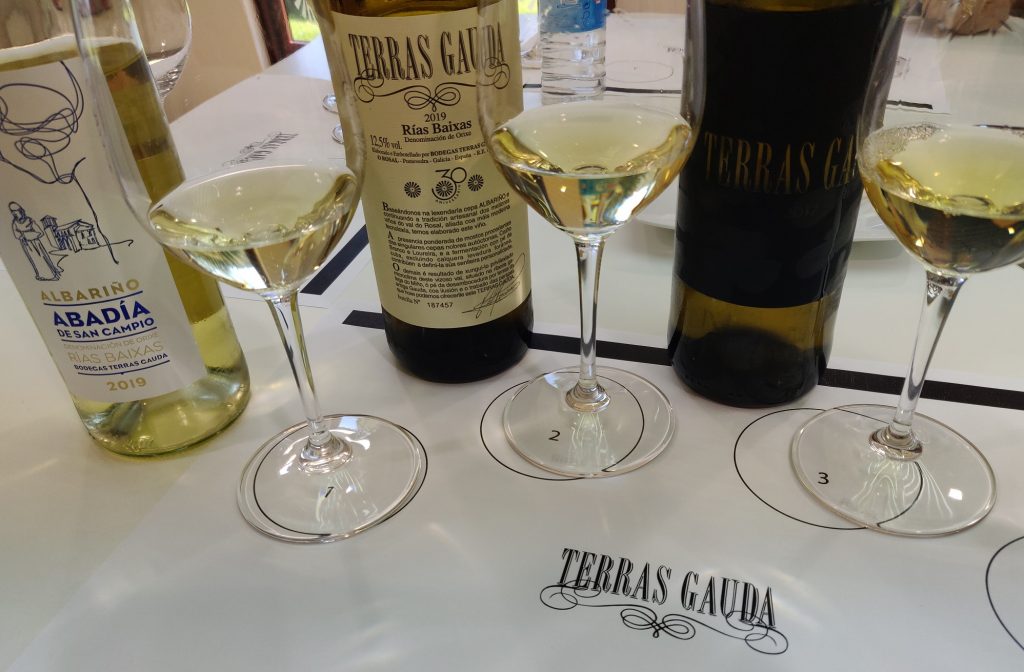
Thirty-five years ago, people would have derided the suggestion that Spain would one day dominate the global white wine market. Yet, in the 2020s, sommeliers are increasingly tempted to scale down their New World Sauvignon Blanc offer in deference to the intense demand for Rias Baixas’s Albariño, Godello, and Rueda’s Verdejo.
Today, the dilemma is where to start rather than a problem of lack of choice. Discover a lifetime of excitement in the vineyards of modern Spain, especially if you seek perfumed, refreshing, and utterly delicious white wines.
Rías Baixas is located in the region of Galicia in northwest Spain along the Atlantic coast. Green rolling hills, misty weather, and granite-rich soils characterize this region, all contributing to the distinctive terroir. Rías Baixas is celebrated for its Albariño wines, known for their crisp acidity and fruit flavors of citrus, lime, and kiwi, with subtle notes of minerality and salinity due to the ocean’s proximity.
The region’s importance lies in its ability to produce some of Spain’s finest white wines, which have gained international acclaim for their freshness, complexity, and perfect pairing with seafood.
Rias Baixas Wine Region Guide: Read more
Types of Wine: White wines
Grapes Varieties:
Rueda, located on the high plateau of Castilla y León in northwestern Spain, features a continental climate with hot summers and cold winters. The region produces beautifully aromatic white wines from the well-draining, gravelly soils.
Rueda is famous for its grape variety, Verdejo, which yields dry wines with vibrant acidity, stone fruit and floral flavors, and subtle herbal notes. Sauvignon Blanc and Viura are also cultivated here and are mainly used as blending tools for the Verdejo.
People prize Rueda’s wines for their quality, versatility, and ability to pair well with various dishes. You will always find them in any bar or restaurant you visit in Spain.
Rueda Wine Region Guide: Read more
Types of Wine: White wines
Grapes:
Penedès is a renowned wine region within Catalonia, just south of Barcelona. The proximity to the Mediterranean Sea mediates hot summer temperatures and cool winters, making it an ideal place for vineyards. Penedès has a variety of white and red grapes due to its varied geography of coastal plains and mountainous terrain, from saline white wines to balanced, refreshing reds.
However, the region is most known for producing sparkling wine, Cava, made primarily from the indigenous grapes Macabeo, Xarel·lo, and Parellada.
Penedès Wine Region Guide: Read more
Types of Wine: White, red, and sparkling wines
Grapes Varieties:
While Spain focuses more on red and white wine production, rosé wines, known as rosados, have gained significant popularity in recent years. Spanish rosados are appreciated for their refreshing acidity and fruit-forward profiles, making them ideal companions for Spain’s sunny Mediterranean climate and vibrant culinary culture.
Navarra, Somontano, and Cigales are among Spain’s most popular rosé wine regions. Each offers unique expressions of rosé characterized by terroir-driven nuances and dedication to quality winemaking practices.
Discover the secrets of Spanish Rosado in our Exclusive Guide to the Country’s Finest Rosé Wines
Navarra is a region known for its diverse wine offerings. It is located in the northeast of Spain, just above Rioja, between the Pyrenees Mountains and the Ebro River. The continental climate, protection from the mountains, and variety of soils make for good growing conditions.
The region is known explicitly for producing refreshing rosados using local grape varieties such as Garnacha and Tempranillo. Beyond rosé, the region also produces white and red wines.
Navarra Wine Region Guide: Read more
Types of Wine: White, red, and rosé wines
Grapes Varieties:
Somontano is another region esteemed for its production of rosado wine. Situated between Navarra and Catalonia along the foothills of the Pyrenees, it is a picturesque lesser-known wine region with high-altitude vineyards. The slate and limestone soils create complex rosés with a distinct minerality.
The rosado wines from this region are primarily crafted from native varieties like Garnacha and Moristel, which are known for their crisp acidity and notes of strawberries and raspberries. The region also produces red and white wines and is rising in popularity as a region of extraordinary versatility with a commitment to sustainability.
Somontano Wine Region Guide: Read more
Types of Wine: White, red, and rosé wines
Grapes Varieties:
Cigales is a small, hidden gem region in Castilla y León, alongside the DOs of Toro and Rueda. This region produces renowned rosé wines, known locally as “clarete,” which are field blends of primarily Tempranillo and Garnacha, along with local white varieties growing alongside the reds. The result is refreshing but complex rosés with red berries, citrus, and subtle herbal and floral notes.
Cigales Wine Region Guide: Read more
Types of Wine: Primarily rosé wines
Grapes Varieties:
Cava, a Spanish sparkling wine, holds a distinguished place in the world of bubbles alongside Champagne and Prosecco, but it is much more affordable than the former. It is predominantly produced in the Penedès region of Catalonia under the DO CAVA. It is made using the traditional method, the same technique employed in Champagne, which involves a second fermentation in the bottle.
This method gives complexity to the wines, imparting savory notes like toasted almonds or brioche. Cava is renowned for its diverse sparkling wines, from crisp and refreshing dry styles to complex, aged reservas and sweet dessert wines.
Cava Wine Region Guide: Read more
Types: Sparkling wine
For a deeper insight into the world of Cava, explore our insider guide to Spain’s sparkling wonder.
Grapes: Macabeo (Viura), Parellada, Xarel-Lo
Sherry, locally known as Jerez, is one of Spain’s most iconic wines. Jerez is produced explicitly in the “Sherry Triangle,” formed by the towns of Jerez de la Frontera, Sanlúcar de Barrameda, and El Puerto de Santa María in the Southwestern part of Spain in the Andalusia region.
The region’s hot, arid climate, paired with its unique chalky soils known as ‘albariza,’ create the perfect environment for growing the signature sherry grapes of Palomino, Pedro Ximinez, and Moscatel. Sherry’s unique solera aging system employs fractional blending of various vintages to give the wines their renowned oxidative aromas and complexity.
Jerez-Xérès-Sherry Wine Region Guide: Read more
Types: Fortified wines, dessert wines, still white wines
You can read more about Sherry wine, its history, production, and diverse styles in our Comprehensive Guide to Sherry Wine
Grapes: Moscatel, Palomino, Pedro Ximénez
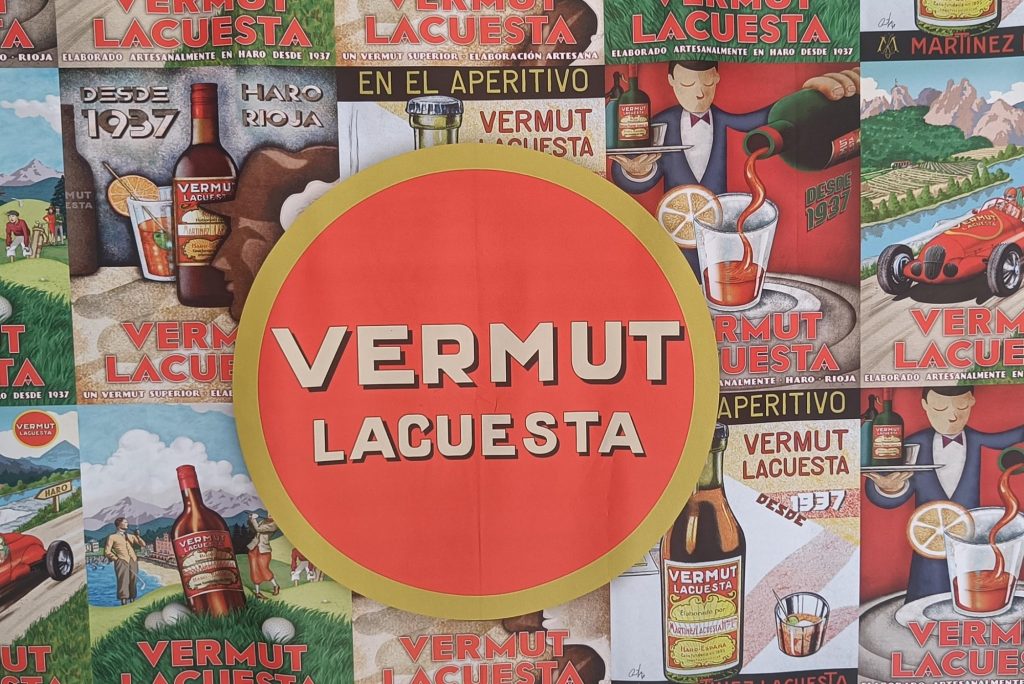
Along with Sherry, Spain has a variety of fortified wines that each have their unique characteristics and flavors.
Vermouth- For many Spaniards, vermouth, or ‘vermut,’ is the aperitif of choice before a big lunch on the weekend and has become a staple of tapas bars and social gatherings throughout the country. Spanish vermouth is made from a base of white wine blended with grape liquor infused with different botanicals, herbs, and spices to create a complex but refreshing drink.
While the ingredients of vermouth vary, they always have a botanical called wormwood, which imparts a bitter flavor to the vermouth, competing with the sweetness to make a dynamic flavor profile.
Montilla-Moriles- Located in the heart of Andalusia, Montilla-Moriles is renowned for its distinctive fortified wines made primarily from Pedro Ximénez. This region’s hot, dry climate and chalky albariza soils create an ideal environment for producing wines with intense, concentrated flavors. Like Sherry, Montilla-Moriles wines range from dry and delicate Fino to the lusciously sweet Pedro Ximénez.
Unlike Sherry, Montilla-Moriles wines often achieve their high alcohol content naturally, without additional fortification, thanks to the high sugar levels in the grapes. The result is a unique array of wines that embody the spirit of Andalucía and its hot, sunny climate.
Málaga– Along the ‘Costa del Sol’ sits Málaga, a sun-drenched coastal city in Andalucía with an incredible climate for making sweet dessert wines. The steep hills along the Mediterranean with diverse soils ranging from slate to sand favor the cultivation of Moscatel and Pedro Ximénez, two varieties with high sugar content that make excellent, complex, sweet wines with notes of honey and dried fruits.
The grapes are often dried out in the sun to concentrate their sugar level further. The proximity to the sea, variety in soil, and steep slopes of the region create very sweet wines with beautiful acidity and complexity, making it a perfect dessert pairing or a ‘liquid dessert’ to have on its own.
Discover more about Spanish Fortified and Dessert Wines

Between the diverse terroirs, variety in wine styles, and the sheer amount of wine produced in Spain, there are countless incredible wines. However, there are a few iconic Spanish wine labels worth highlighting for their exceptional quality, which reflects their terroir, aging potential, and international acclaim.
Vega Sicilia Único—From Ribera del Duero, Único is one of Spain’s most prestigious wines from the iconic Vega Sicilia winery. A blend of Tempranillo and Cabernet Sauvignon, it’s aged for ten years. more info
Pingus—Also from Ribera del Duero, Pingus is the creation of legendary Danish winemaker Peter Sisseck. It is a Tempranillo crafted from old-vine vineyards. more info
La Rioja Alta Gran Reserva 904 — a classic Rioja wine highly regarded for its delicate silkiness and finesse. It showcases red fruits while maintaining a beautiful structure and long finish. more info
Alvaro Palacios L’Ermita — L’Ermita is a red blend from the Priorat made from grapes planted on steep slopes of schist soils. read more
Marqués de Riscal Reserva—This wine is one of the most famous Spanish wines, domestically and abroad, for its long history of consistent quality as a classic Rioja Reserva. more info
Toro Albala Don PX Convento Selección —A luxuriously sweet, deep, rich dessert wine from Pedro Ximénez grapes, it was the first sweet wine to receive 100 points from Robert Parker. more info
Artadi Viña El Pisón—From Rioja Alavesa, this single-vineyard Tempranillo wine features intense fruit flavors, fine tannins, and a mineral character that reflects its unique terroir. more info
Clos Mogador—Showcases concentrated flavors of dark fruits, spices, and minerality from a blend of Garnacha, Cabernet Sauvignon, Syrah, Merlot, and Pinot Noir. more info
Benjamin Romeo, Contador—A cult wine from the Rioja, this Tempranillo blend is known for its exceptional quality, complex flavors, and impressive finish. more info
Bodegas Muga, Aro—Only produced during the best vintages, this Tempranillo-Graciano blend from the high-altitude vineyards of Rioja Alta. more info
Spain’s wine industry is witnessing a wave of innovation as a new generation takes over, exploring new, lesser-known regions and employing the latest techniques and technology. Comando G , the project of Fernando García and Daniel Landí in Sierra de Gredos, comes to mind.
These two winemakers have spent over a decade recuperating the isolated, rugged, and often abandoned vineyards with old Garnacha vines. The result is unique blends of Garnacha that are complex, elegant, and representative of Spain’s new winemaking generation (New York Times).
In the north, winemaker Raúl Pérez is producing incredible wines from regions with cooler temperatures that will only grow in popularity as climate change continues to impact Spanish viticulture. In an interview,
Raúl Pérez says:
“growing a village isn’t just about the soil, it’s about your neighbors and helping one another to make great wine. We’re friends here.“
And with the changing climate, we see more and more producers and even regions, like Penedes, band together to adopt more sustainable farming practices nationwide.
Spain has many wine-producing regions filled with incredible wines ranging in style and winemaking techniques. These wines are made from indigenous grape varieties that honor the country’s rich viticultural heritage. You could spend a lifetime exploring and drinking your way through this country.
If you would like us to customize an exclusive luxury tour, contact us and let us know your travel plans. We offer luxury food and wine tours for private groups of a minimum two guests. In addition, all of our private, chauffeured tours are available year-round upon request.

